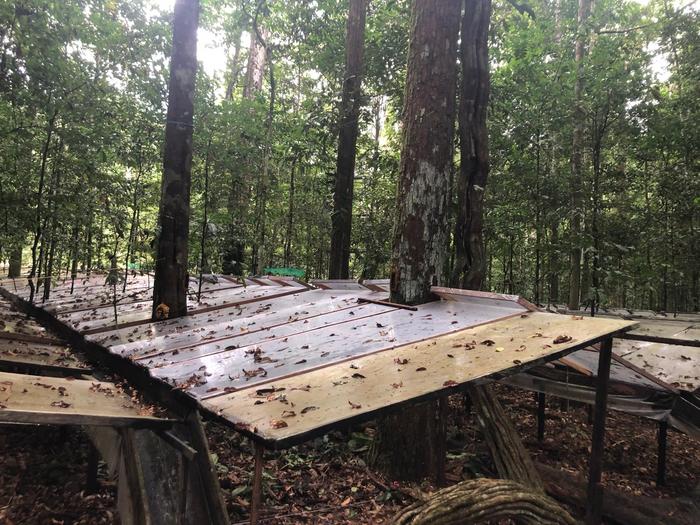Scientists have uncovered surprising evidence that the Amazon rainforest can survive prolonged drought conditions, but at a significant cost to its carbon storage capacity and structure.
In a 22-year experiment, researchers found that after losing more than one-third of its biomass during an initial 15-year “transition phase,” the forest reached “eco-hydrological stability” with surviving trees no longer experiencing drought stress. This discovery, published in Nature Ecology and Evolution, offers crucial insights into how Earth’s largest rainforest might respond to climate change—suggesting resilience against complete collapse but warning of substantial carbon losses that could accelerate global warming.
The study, led by researchers from the University of Edinburgh and the Federal University of Para in Brazil, represents the world’s longest-running drought experiment in tropical rainforest. By redirecting approximately 50% of rainfall away from a one-hectare forest plot since 2002, scientists created conditions that simulate the prolonged drought many climate models predict for the Amazon region.
Forest Transforms Rather Than Collapses Under Long-Term Drought
For decades, scientists have worried that increasing drought in the Amazon could trigger a catastrophic “tipping point,” potentially converting lush rainforest into savanna. This experiment provides evidence for a more nuanced outcome.
“Our findings suggest that while some rainforests may be able to survive prolonged droughts brought on by climate change, their capacity to act as both a vital carbon store and carbon sink could be greatly diminished,” explains Dr. Pablo Sanchez Martinez of the University of Edinburgh’s School of GeoSciences, lead author of the study.
During the first 15 years of experimental drought, the forest lost approximately 85 megagrams of carbon per hectare—representing a 34% reduction from its initial biomass. This loss disproportionately affected the largest trees, which are crucial for carbon storage and ecosystem function.
However, something unexpected happened next. Instead of continuing to decline, the forest stabilized during the following seven years at about 164 megagrams of carbon per hectare. This biomass level is still substantially higher than tropical savannas (49 megagrams) and closer to that of tropical dry forests (125 megagrams).
Trees Reach “Hydraulic Homeostasis” After Forest Thins
The research team discovered that the surviving trees showed remarkable adaptation to the drier conditions. By 2023—more than two decades into the experiment—trees in the drought plot displayed similar levels of hydraulic stress as trees in the control plot, despite receiving half the rainfall.
How did this happen? As the forest lost trees during the transition phase, the remaining trees gained access to more water per unit of biomass—a measure the researchers call “biomass-relative water availability.” This ecological adjustment allowed surviving trees to maintain healthy transpiration rates and tissue water content, even during dry seasons.
This surprising finding contradicts concerns that drought would cause continuous decline until ecosystem collapse. Instead, the forest underwent structural reorganization, transitioning to a more open canopy with fewer large trees but still maintaining forest characteristics.
Major Carbon Losses Before Stabilization
The ecological price of this adaptation was steep. The experiment revealed several critical changes in forest carbon dynamics:
- Loss of 34% of initial forest biomass (85 megagrams of carbon per hectare)
- Disproportionate mortality among the largest trees
- Forest switched from being a carbon source during the transition phase to a small carbon sink during stabilization
- Carbon accumulation in the stabilized forest remains lower than in undisturbed rainforest
- Structural changes resulted in a more open canopy with fewer emergent trees
“While it prevented drought-induced collapse, eco-hydrological stabilization resulted in a forest with reduced biomass and carbon accumulation in wood,” the researchers note in their paper. If this pattern were to occur across large portions of the Amazon, it would release enormous amounts of stored carbon into the atmosphere, potentially accelerating climate change.
Implications for Amazon’s Future Under Climate Change
What might these findings mean for the larger Amazon basin, which stores approximately 123 billion tons of carbon in its trees and plays a critical role in regulating Earth’s climate?
The researchers caution that their experiment only simulated soil drought in a small area. Real-world climate change will likely bring additional stressors, including higher temperatures, increased atmospheric dryness, stronger winds, and more frequent fires. The combined effects could cause more severe or prolonged biomass loss before stabilization.
“Ecological responses to climate can have very large impacts on our environment, locally and globally; we cannot understand and predict them without long-term collaborative research of this sort,” says Professor Patrick Meir of the University of Edinburgh’s School of GeoSciences.
Nevertheless, the study offers cautious optimism about the Amazon’s fundamental resilience. Rather than experiencing “ecosystem collapse” under prolonged drought, the forest appears capable of transitioning to an alternative stable state—albeit one with significantly less biomass.
As climate change intensifies and parts of the Amazon experience more frequent and severe droughts, this research provides vital insights into how this crucial ecosystem might transform in the coming decades. While the Amazon may avoid the worst-case scenario of complete conversion to savanna, the massive carbon losses during its adaptation phase could have profound implications for global climate targets and the fight against climate change.
If our reporting has informed or inspired you, please consider making a donation. Every contribution, no matter the size, empowers us to continue delivering accurate, engaging, and trustworthy science and medical news. Independent journalism requires time, effort, and resources—your support ensures we can keep uncovering the stories that matter most to you.
Join us in making knowledge accessible and impactful. Thank you for standing with us!

